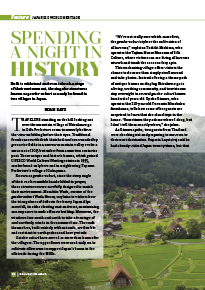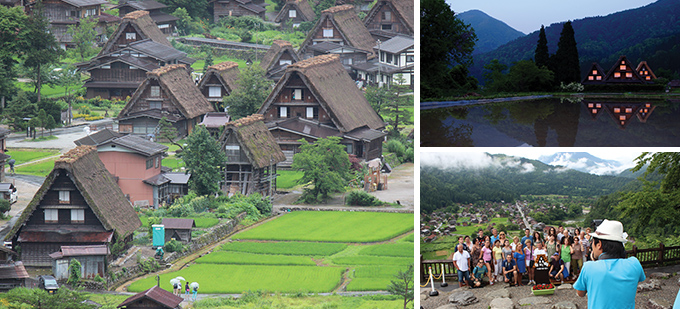Home > Highlighting JAPAN >Highlighting Japan September 2015>Japanese World Heritage
Highlighting JAPAN

Japanese World Heritage
Spending a Night in History
Built to withstand and even take advantage of their environment, the singular structures known as gassho-zukuri can only be found in two villages in Japan.

Travelers standing on the hill looking out over the mountain village of Shirakawa-go in Gifu Prefecture seem to scarcely believe the view unfolding before their eyes. Traditional farmhouses with thick thatched roofs surrounded by green rice fields in a narrow mountain valley evoke a scene not of 2015 but rather from some two centuries past. These unique and historic homes, which gained UNESCO World Cultural Heritage status in 1995, can be found only here and in neighboring Toyama Prefecture’s village of Gokayama.
Known as gassho-zukuri, since the steep angle of their roofs resemble hands folded in prayer, these structures were carefully designed to match their environment. Masahito Wada, curator of the gassho-zukuri Wada House, explains to visitors how the triangular roof deflects the heavy Japan Alps snowfall, its sides slanting east and west, maximizing sun exposure to melt off snow buildup. Moreover, the windows face south and north to take advantage of cool northerly winds in the summertime. The roofs themselves, built entirely without nails, are flexible and resistant to earthquakes and heavy winds.
Gassho-zukuri have served as more than homes for the villagers. The upper floors were used early on to cultivate silkworms to support Japan’s boom in the silk trade during the 1800s.
“We’re not really sure which came first, the gassho-zukuri style or the cultivation of silkworms,” explains Toshiki Mishima, who operates the Tajima House Museum of Silk Culture, where visitors can see living silkworms at work and touch the cocoons they spin.
This enchanting village offers visitors the chance to do more than simply stroll around and take photos. Instead of being a theme park of antique homes on display, Shirakawa-go is a living, working community, and tourists can stay overnight in several gassho-zukuri homes hundred of years old. Kyoko Kimura, who operates the 210-year old Furusato Minshuku farmhouse, tells how some of her guests are surprised to learn that she also sleeps in the house. “Sometimes they ask me where I sleep, but I don’t tell them exactly where,” she jokes.
As Kimura spoke, two guests from Thailand were checking out and preparing to move on to their next destination. Supasin Laysiriroj said he had already visited Japan twenty times, but that this was his first chance to stay in Shirakawa-go. “We were looking for the traditional Japanese lifestyle, so we chose to stay in this kind of accommodation. You can’t find this kind of lifestyle in Tokyo,” he explains.
Even the meals available inside these unique lodgings are local, a point that Tomoyuki Murata of the Shirakawa-go Tourist Association considers special. “The food uses nearly all local ingredients,” he says.
Depending on the time of day, and of course the season, visitors may find Shirakawa-go specialties such as hoba miso (fermented soybean paste grilled on magnolia leaves), soba (buckwheat) noodles and freshwater fish called iwana (char) on their tray. In particular, Murata recommends a kind of hard tofu called ishi-dofu that is unique to Shirakawa-go and Gokayama.
Murata says that while visitors to this region have ample choices for accommodation in other cities, those staying at the gassho-zukuri can relax and truly feel at home. He adds that lodging inside a World Heritage Site like these farmhouses is a unique opportunity for “those that want to see culture taking shape.”
© 2009 Cabinet Office, Government of Japan






